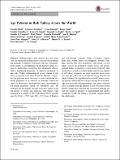"Age patterns in risk taking across the world": Correction.

View/
Publication Date
2020Author
Duell, Natasha Steinberg, Laurence Icenogle, Grace Chein, Jason Chaudhary, Nandita Di Giunta, Laura Dodge, Kenneth A. Fanti, Kostas A. Lansford, Jennifer E. Oburu, Paul Pastorelli, Concetta Skinner, Ann T. Sorbring, Emma Tapanya, Sombat Uribe Tirado, Liliana Maria Alampay, Liane Peña Al-Hassan, Suha M. Takash, Hanan M. S. Bacchini, Dario Chang, Lei
Metadata
Show full item recordAbstract/
Reports an error in "Age patterns in risk taking across the world" by Natasha Duell, Laurence Steinberg, Grace Icenogle, Jason Chein, Nandita Chaudhary, Laura Di Giunta, Kenneth A. Dodge, Kostas A. Fanti, Jennifer E. Lansford, Paul Oburu, Concetta Pastorelli, Ann T. Skinner, Emma Sorbring, Sombat Tapanya, Liliana Maria Uribe Tirado, Liane Peña Alampay, Suha M. Al-Hassan, Hanan M. S. Takash, Dario Bacchini and Lei Chang (Journal of Youth and Adolescence, 2018[May], Vol 47[5], 1052-1072). In the original publication, the legends for Figs 4 and 5 were incorrect, such that each regression line was mislabeled with the incorrect country. The figures with the correctly labeled countries are included in the erratum. (The following abstract of the original article appeared in record 2017-47562-001). Epidemiological data indicate that risk behaviors are among the leading causes of adolescent morbidity and mortality worldwide. Consistent with this, laboratory-based studies of age differences in risk behavior allude to a peak in adolescence, suggesting that adolescents demonstrate a heightened propensity, or inherent inclination, to take risks. Unlike epidemiological reports, studies of risk taking propensity have been limited to Western samples, leaving questions about the extent to which heightened risk taking propensity is an inherent or culturally constructed aspect of adolescence. In the present study, age patterns in risk-taking propensity (using two laboratory tasks: the Stoplight and the BART) and real-world risk taking (using self-reports of health and antisocial risk taking) were examined in a sample of 5227 individuals (50.7% female) ages 10–30 (M = 17.05 years, SD = 5.91) from 11 Western and non-Western countries (China, Colombia, Cyprus, India, Italy, Jordan, Kenya, the Philippines, Sweden, Thailand, and the US). Two hypotheses were tested: (1) risk taking follows an inverted-U pattern across age groups, peaking earlier on measures of risk taking propensity than on measures of real-world risk taking, and (2) age patterns in risk taking propensity are more consistent across countries than age patterns in real-world risk taking. Overall, risk taking followed the hypothesized inverted-U pattern across age groups, with health risk taking evincing the latest peak. Age patterns in risk taking propensity were more consistent across countries than age patterns in real-world risk taking. Results suggest that although the association between age and risk taking is sensitive to measurement and culture, around the world, risk taking is generally highest among late adolescents. (PsycINFO Database Record (c) 2019 APA, all rights reserved)
Collections
- Department of Psychology [216]
